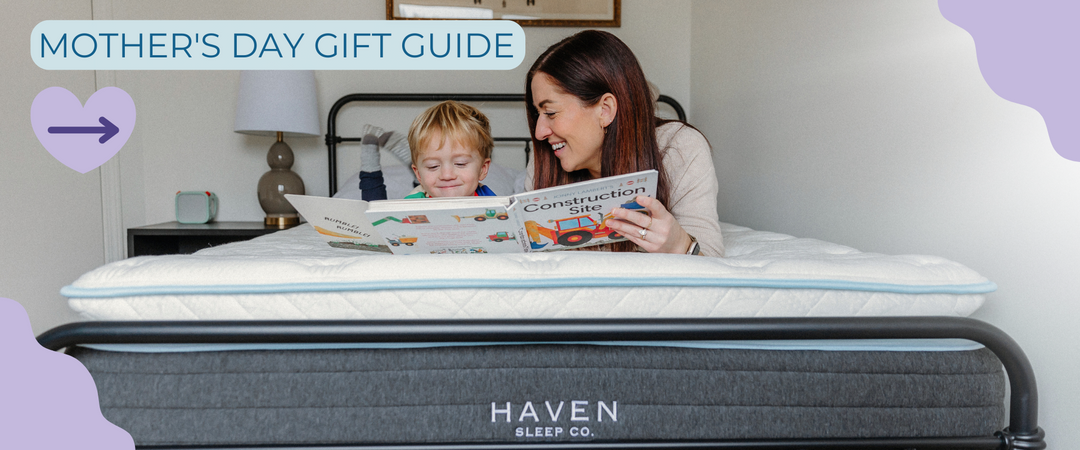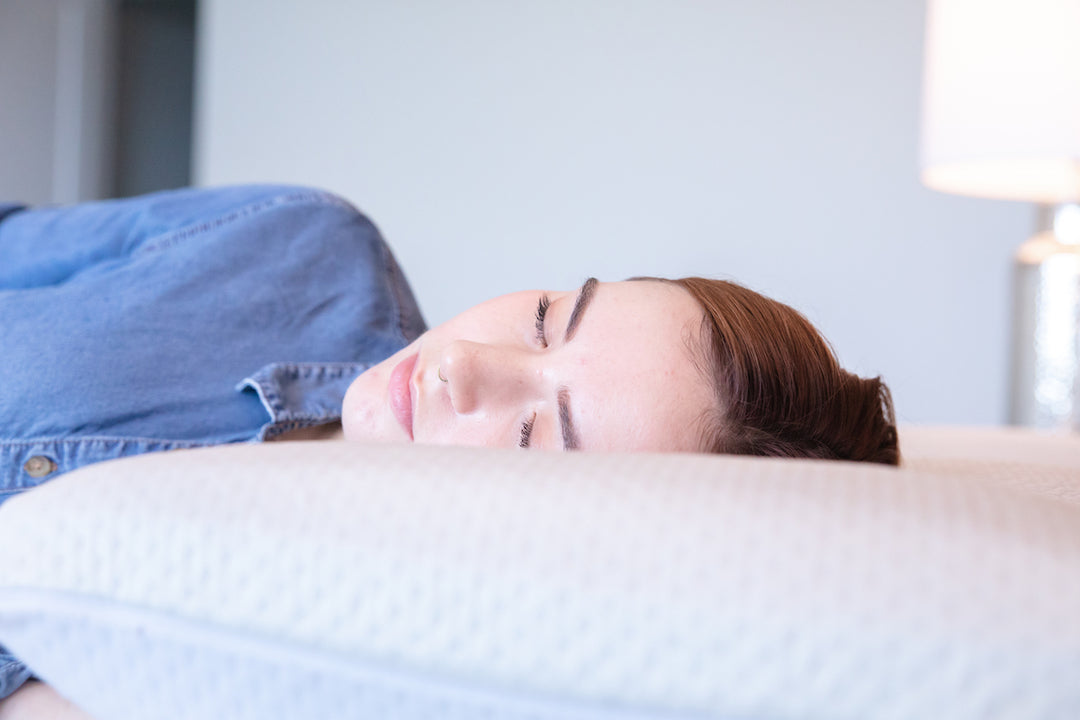
Weighted blankets for deep pressure therapy: How does it work?
Deep pressure therapy is routinely used to help individuals with autism and sensory disorders cope better, but you don’t need to have one of these conditions to use this form of therapy.
In fact, if you’re:
- Not sleeping well
- Stressed out from work
- Feeling anxious
- Unable to concentrate
Then you’ll also benefit from deep pressure therapy.
Curious to learn about how deep pressure therapy works, and how you can administer this form of therapy to yourself?
Read on to find out more!
What is deep pressure therapy?
Deep pressure therapy is also known as deep touch therapy or deep pressure stimulation.
According to Dr Temple Grandin, who created the squeeze machine that administers deep pressure therapy, DPT is defined as the type of "surface pressure" that is exerted in most types of firm touching, holding, stroking, petting of animals, or swaddling.

So when you swaddle a baby that’s fussing, and they quickly calm down and go to sleep, that’s deep pressure therapy.
When you get a full body massage, and you feel your body unwinding and relaxing, that’s also deep pressure therapy.
As mentioned earlier, deep pressure therapy is beneficial to pretty much all folks -- including people suffering from certain medical conditions, and others who are just overly-stressed from work.
We’ll walk you through about the science of how deep pressure therapy works in the next section, but if you’d like to learn more how this therapy helps people with autism and sensory processing disorders, check out this research from Harvard.
How does deep pressure therapy work?
Receive some form of deep pressure → feel better. It sounds simply in theory, but there’s actually a LOT going on behind the scenes.
Now, to understand how deep pressure therapy works, you’ll have to first learn about two of your body’s nervous systems: the sympathetic system and the parasympathetic system.
In your day-to-day, your body relies on the parasympathetic nervous system. Some folks call this the rest and recovery system; others term it the rest and digest system.

What does this system do? Well, it’s responsible for stimulating activities that occur when your body is at rest, such as:
- Digestion
- Salivation
- Urination
- Defecation
- Sexual arousal
You know, day to day stuff.
While your body is in this system by default, it switches over to the sympathetic system when it’s triggered by a threat (or a perceived threat).
The stress response begins in your brain, with the brain sending signals to the adrenal glands to activate the sympathetic nervous system.
When this happens, the adrenal glands start pumping adrenaline into your bloodstream, and your body goes into “flight or fight” mode. Physical symptoms include:
- Your heart beating faster
- Your blood pressure increasing
- More rapid breathing
Here, your lungs are trying to take in as much oxygen as possible -- this way, it can increase the amount of oxygen that it channels to your brain, thereby increasing the brain’s alertness.
Once the threat (or perceived threat) is removed, your body will slowly switch back to the parasympathetic nervous system. Assuming that this doesn’t happen too often, there’s no harm done.
But what if you’re constantly in stressful situations, and your body is always in the flight or fight mode?

If that’s the case, you’ll eventually overwhelm your nervous system, and this can trigger anxiety, panic attacks, and more.
That’s where deep pressure therapy comes in.
By applying deep pressure therapy, you can help your body move from the sympathetic nervous system to the parasympathetic nervous system.
Here’s how it works: deep pressure therapy activates “feel good” hormones such as dopamine and serotonin, and these counteract the stress hormones in your body.
As your stress levels drop, your breathing and blood pressure goes back to normal, and your parasympathetic nervous system takes over once again.
The discovery of deep pressure therapy
Deep pressure therapy has actually been around for a long time -- therapists have used it to calm their patients down since the 1990s.
If you’re wondering how we got to know about deep pressure therapy and its applications, the credit goes to Dr Temple Grandin, who’s on the autism spectrum herself.

Here’s how the story goes: Dr Temple Grandin was visiting her aunt’s farm in Arizona, and as she was looking at the chute used to vaccinate cattle, she noticed that cattle who were confined in the chute calmed down after being squeezed.
After observing this phenomenon, Dr Grandin decided to build a squeeze machine for humans, thinking that the act of squeezing might also help to reduce anxiety in humans.
Once the machine was up and running, researchers conducted a couple of studies, and found that the machine was useful in helping people alleviate stress and anxiety.
The machine was tested out on both children with autism, and college students who didn’t suffer from any medical conditions, and in both instances, the participants reported feeling calmer and more relaxed.
Using a weighted blanket for deep pressure therapy
Squeeze machines are used by therapists and medical professionals till this day, but unfortunately, they’re too expensive for the average person to afford.
However, there are other ways in which laypeople can benefit from deep pressure therapy -- such as using a weighted blanket.

If this is the first time you’re hearing about weighted blankets, they’re essentially blankets that are filled with “stuffers” in order to make them heavy.
These blankets exert a calming pressure on your body, and they make it easier for you to fall asleep, and allow you to improve your quality of sleep.
Basically, weighted blankets allow you to achieve all the benefits of using a squeeze machine, but they’re a lot more cost-effective and easy to use.
In fact, these are now so popular, mainstream news publications and websites have taken to reviewing them. Check it out:
- Business Insider: I've been sleeping with this weighted blanket for 6 months, and I've noticed a huge change in the quality of my sleep.
- Healthline: Why This 15-Pound Weighted Blanket Is Part of My Anti-Anxiety Routine.
- NBC News: I tried using a weighted blanket to stress less. Here's what happened.
How to choose the perfect weighted blanket
There are all sorts of weighted blankets out there, so how do you know which you should get?
First things first: make sure you purchase a weighted blanket that’s sufficiently heavy.
Generally speaking, a weighted blanket should be 10% of your body weight. If that 10% falls in between two options, and you have to choose between a heavier or a lighter weighted blanket, opt for a heavier one.
On top of that, you’ll also want to get a weighted blanket that’s versatile to be used in different seasons. Here, weighted blankets that come with removable covers are the best.
If it’s cold, use your weighted blanket with its cover -- this will generate more heat, and ensure that you have a great sleep.
If it’s warm, remove the cover, and sleep with just the inner weighted blanket. This way, you’ll keep cool throughout the night.
Last but not least, it’s important to get a weighted blanket that’s machine-washable, for easy maintenance.
Generally, weighted blankets that are filled with glass beads or glass sand should be able to go into your washing machine.
If you own a weighted blanket that’s filled with plastic poly pellets, check with the brand or manufacturer -- you probably can machine-wash this, but depending on the melting point of the plastic pellets, you may or may not have to use a cold wash.
Lastly, weighted blankets that are filled with “alternative” stuffers such as grain, sand, and buckwheat cannot be washed at all.
These organic stuffers expand when they come into contact with water, and don’t dry thoroughly. If you wash a blanket that’s filled with buckwheat, chances are that your blanket will start to rot.
Try a weighted blanket with ZERO risk
Want to experience the magic of a weighted blanket yourself?
Here at Hush Blankets, we offer a 100 Night Guarantee on all our blankets -- so that our customers can try our blankets, risk-free.
Now, we’ve received plenty of great feedback about our blankets, and most folks tell us that our blankets have drastically changed their lives.
But on the off-chance that you don’t like the blanket, just ship it back to us within 100 nights. We’ll process a full refund for you, inclusive of shipping fees.








